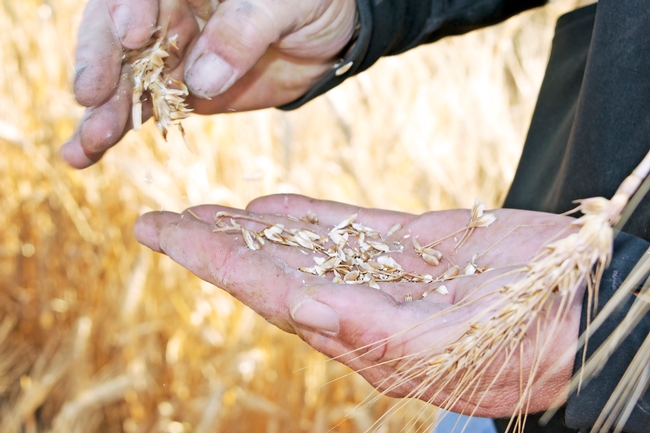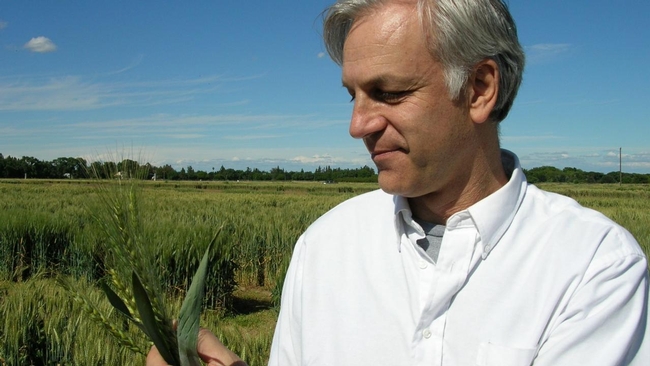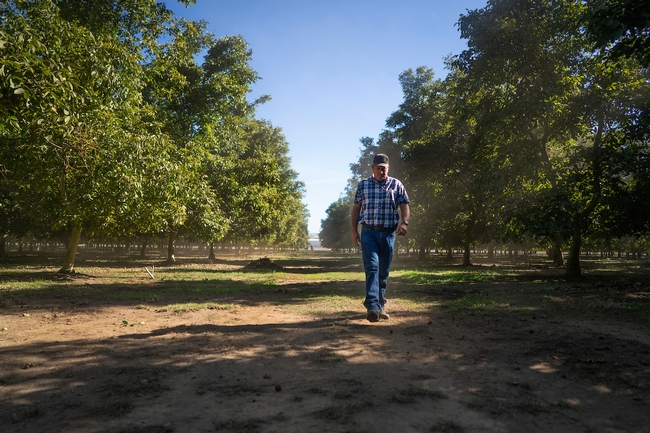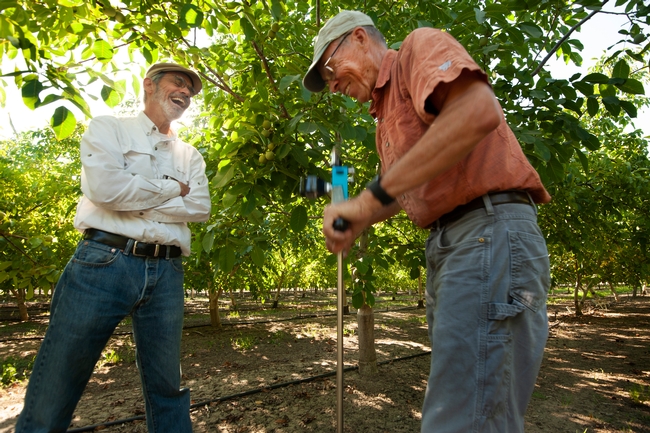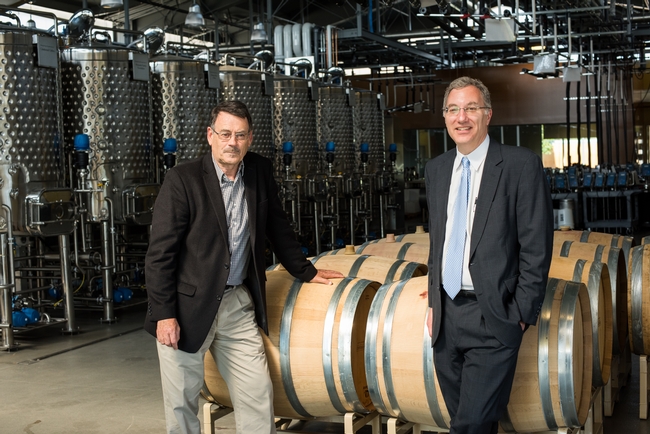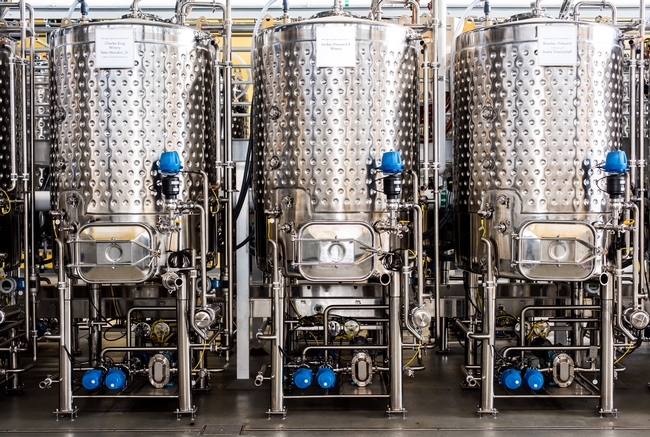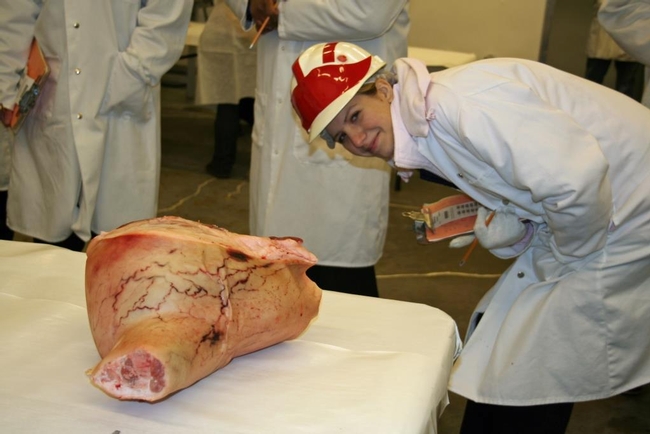Posts Tagged: UC Davis College of Agricultural and Environmental Sciences
UC Davis team identifies wheat gene that increases yield
The findings could help growers produce more wheat without expanding operation
A team of scientists from University of California, Davis, have identified a new gene variant in wheat that can increase the amount of the grain produced, new research published in the journal PLOS Genetics finds.
Wheat is a staple of food diets worldwide and the gene discovery could allow farmers to grow more food without increasing land use. Increased yield could also lower consumer prices, making the crop more accessible.
“We have a growing human population that likes to eat every day,” said Jorge Dubcovsky, a plant sciences distinguished professor who led the research. “We need to produce more wheat in the same space so we need plants that are more productive.”
The researchers found a gene – WAPO1 – that controls the maximum number of grains in a wheat spike. Breeding the beneficial gene variant into the plants could delay the formation of the terminal spikelet, providing room for more grains to grow in each spike rather than ending production of grain.
WAPO1 is one of the first genes discovered that can affect wheat yield. “We are trying to make more productive wheat varieties and we are starting to understand how that trait is controlled,” Dubcovsky said.
Pasta wheat lacking the gene
The gene variant for high grain number is found frequently in bread wheats but not in pasta wheats. By breeding the beneficial gene variant into those pasta wheat varieties, growers could increase yield by 4% to 5% in cultivars that have the biomass capacity to fill the extra grains.
“We developed molecular markers to select for the form of that gene to produce increased yield,” Dubcovsky said. “It's a significant step forward.”
Previous research by the team mapped the gene and identified others that could affect yield. This research confirmed those findings for WAPO1.
Discovery on path to future yield increases
The WAPO1 gene is part of a network of genes that work together to control yield, and researchers need to identify the best variant combinations to maximize yield. Solving this puzzle can lead to better production rates.
“We will continue to try to understand the network of genes that control the yield of wheat,” he said.
Saarah Kuzay, Huiqiong Lin, Chengxia Li, Shisheng Chen, Daniel P. Woods and Junli Zhang from UC Davis also contributed to the research, as did scientists from Howard Hughes Medical Institute, Heinrich Heine University and Peking University Institute of Advanced Agricultural Sciences.
Funding was provided by USDAs National Institute of Food and Agriculture's Food Research Initiative, the International Wheat Yield Partnership and Howard Hughes Medical Institute.
A nutty idea: A little stress could be good for walnuts
When it comes to watering walnuts, most California growers believe you need to start early to keep trees healthy and productive throughout the long, hot summer. But according to striking results from a long-term experiment in a walnut orchard in Red Bluff, growers can improve crop production if they hold off irrigation until later in the season and directly measure their trees' water needs.
The findings from researchers at the University of California may help farmers optimize water use.
“It's a game-changer,” said walnut grower Hal Crain, who welcomed researchers on to his orchard to test irrigation optimization. “It's clear to me you can improve nut quality and yield by applying water based on what the tree wants and needs, rather than just watering when it's hot outside and the soil is dry. That's a big deal for walnut growers and for the entire agricultural industry.”
Changing the paradigm
Crain is a second-generation farmer whose family has been growing walnuts in Butte and Tehama counties for 55 years. Like most walnut farmers, Crain had always started irrigating in early to mid-May when the days grew warmer and the trees sprouted leaves.
“That's standard practice for probably 90 percent of California's walnut growers,” said Crain, walking amid his trees on a sunny afternoon. “The theory is that when you irrigate early, you preserve the deep moisture in the soil that trees need to survive the heat of summer.”
But that's not how it works, the research shows. Instead, trees that grow in saturated soil early in the season don't develop the deep roots they need to thrive.
“With all the water right there at the surface, the lower roots suffer,” explained Bruce Lampinen, UC Cooperative Extension orchard management specialist with the UC Davis Department of Plant Sciences. “Trees end up with a very shallow root system, which doesn't serve them well as they try to extract moisture from the soil later on.”
Lampinen has long suspected that walnuts were getting too much water in the spring.
“A lot of the symptoms we see like yellowing leaves and various diseases can all be explained by overwatering,” said Lampinen.
So Lampinen did what scientists do: He set up an experiment. Five years ago, with funding from the California Walnut Board and the U.S. Department of Agriculture, he joined forces with Ken Shackel, a plant sciences professor with UC Davis, and Allan Fulton, an irrigation adviser with UC Cooperative Extension. Together, they led a team of scientists testing irrigation on Crain's ranch.
“Hal is an exceptional partner,” Fulton said. “Farmers have a lot to accommodate when they host an experiment like this, with researchers going in and out of the orchard at all hours. He had to work around our people and the timing of our water treatments. He's always eager to experiment with technology and learn new things, and he shares what he learns with other growers. Hal completes the circle.”
Tough nut to crack
When is the best time to irrigate? Researchers say the trees hold the answer. Scientists use pressure chambers, which are air-pressure devices that measure a leaf or small shoot to gauge how hard the plant is working to pull moisture from the soil.
“Just because the soil looks dry doesn't mean the plant is suffering,” said Shackel, who specializes in plant physiology. “Pressure chambers let you ask the tree how it's feeling — sort of like taking a human's blood pressure — which is a much more accurate way to measure a plant's water needs.”
For the last five years, the team has been applying different water treatments to five blocks of trees. One block is getting standard, early irrigation. Crain's orchard managers begin irrigating the other blocks when the trees reach different levels of water stress based on pressure-chamber readings.
The trees that experience moderate stress are doing the best. Their irrigation usually starts in mid-to-late June, several weeks later than when standard watering begins.
“You can tell just by looking at that block that the trees are healthier,” said Crain, standing beneath a canopy of lush, green trees. “And, we're starting to see greater yields and better nut quality.”
Translating the research
The research is helping scientists advise farmers on irrigation.
“My biggest take-away is knowing when to start watering is a really important factor to the health of your trees,” Lampinen says.
Pressure chambers — sometimes called pressure bombs — can cost more than $3,000, and high-tech versions are under development.
“I tell growers a pressure bomb would pay for itself even if you just used it once a year to determine when to start watering,” Lampinen said.
Crain is certainly convinced.
“When you irrigate based on your trees' needs, you optimize water,” Crain says. “I'm not using less water overall, but the water I do use is producing more food. That's good news for everyone.”
This story was originally published in the Fall 2018 issue of Outlook Magazine, the alumni magazine for the UC Davis College of Agricultural and Environmental Sciences.
Helping winemakers sustainably produce premium wine
Ten large, shiny tanks stand near the Robert Mondavi Institute for Wine and Food Science at UC Davis, holding more than a year of rainwater and the key to processing food and drink during a drought. The water tanks, and the teaching-and-research winery they support, are showing students and winemakers throughout the world how to reduce processing costs, improve wine quality, and protect the planet's dwindling natural resources.
“It's about self-sufficiency,” says Roger Boulton, UC Davis professor of enology and chemical engineering. “We're demonstrating how you can operate a winery, brewery, or any food processing plant with the water that falls and the sun that shines on your roof.”
The work is the latest in more than a century of trail-blazing viticulture and enology science at UC Davis. UC Davis researchers are working with Cooperative Extension specialists and farm advisors with UC Agriculture and Natural Resources to help winemakers and grape growers sustainably produce premium wine.
Water is critical to winemakers in drought-stricken California and beyond. Grapes aren't a very thirsty crop to grow, but keeping fermentors clean is another story.
A typical winery uses four to six gallons of water after the grapes are harvested to produce one gallon of wine, and most of that water is used to wash equipment. Boulton and David Block, chair of the UC Davis Department of Viticulture and Enology, are developing self-cleaning fermentors capable of recycling 90 percent of that water. The goal: affordable technology and alternative practices that use less than one gallon of water to produce one gallon of wine.
Winemakers currently remove sticky, fermented, grape residue from tanks with water and elbow grease. Clean-in-place technology replaces hand-cleaning with an automated system that sprays tanks with diluted solutions of potassium hydroxide and potassium bisulfate.
“The dairy industry has used clean-in-place technology since the 1960s and the pharmaceutical industry since the 1990s,” says Block, a chemical engineer and enologist who helped the pharmaceutical industry manage clean-in-place technology before coming to UC Davis in 2008. “It's a little different with dairy and pharmaceuticals, where poor sanitation can kill you, but the concept is similar.”
So the water tanks near the Robert Mondavi Institute have two functions, to store water captured during the wet season to use during the dry season when it's needed most, and to filter and purify the water as it's used and reused to clean fermentors.
“We will filter and reuse that water at least five times, hopefully one day up to 10 times,” Boulton says. “It's not waste water. It has no phosphates, no nitrates, and no chlorine. Clean-in-place technology represents a huge potential for water and labor savings.”
Industry is starting to notice.
“Clean-in-place technology is very attractive to us,” says Ashley Heisey, director of winemaking at Long Meadow Ranch in Rutherford and a UC Davis viticulture and enology graduate. “Water is such a critical issue. Long Meadow Ranch owners Ted, Chris, and Laddie Hall built our facilities with great concern for the environment, and thanks to UC Davis, we can take it one step further.”
In Sacramento, grocer Darrell Corti from Corti Brothers Market says where UC Davis leads, winemakers will eventually follow.
“What we know about grape-growing and winemaking is primarily due to the work they do at UC Davis,” Corti says.
A longer version of this story is in the magazine Edible Sacramento.
Future looks bright at UC Ag Field Day
More than 3,500 FFA and 4-H high school students from California and surrounding states will gather on March 6 and 7 at UC Davis for the annual Agricultural and Environmental Sciences Field Day. The smart, passionate youth will compete in two dozen agriculture contests, from livestock judging, to agricultural mechanics, to floriculture, to computer applications, and more.
FFA (formerly known as Future Farmers of America) and 4-H are youth development programs that help prepare young people for careers in the rapidly changing world of agriculture. 4-H, which is offered in California by UC Agriculture and Natural Resources Cooperative Extension, allows members to choose from projects in science, engineering, technology, animal science education, nutrition, healthy living and many other experiential learning activities.
Each year the young competitors spend countless hours preparing for the field day, the largest of its kind in the state.
“Competing in Ag Field Day instilled in me the importance of a strong work ethic, the value of research, and the benefits of scientific methods for solving real-world problems in agriculture,” said Yousef Buzayan, a 2011 Ag Field Day participant now double-majoring in Managerial Economics and International Agricultural Development at UC Davis.
Ag Field Day is run and managed completely by UC Davis students who gain valuable experience in leadership, communication, and teamwork.
“Of all my experiences at UC Davis, managing Ag Field Day was definitely the biggest challenge, and with it came the biggest rewards,” said Mary Kimball, executive director of the Center for Land-Based Learning in Winters, California, who helped organize Ag Field Day as a student in 1992. “I learned how to manage many moving parts, and I learned that the best way to get things done well is to do it as a team.”
So if you're in Davis and see thousands of high school students on campus, you'll know who they are: tomorrow's leaders striving and thriving in Ag Field Day competitions. The future of agriculture is in good hands.?


